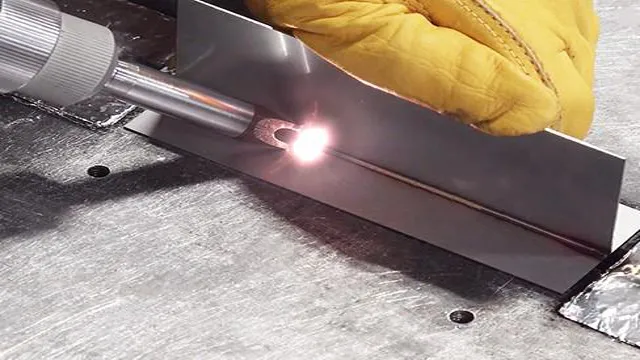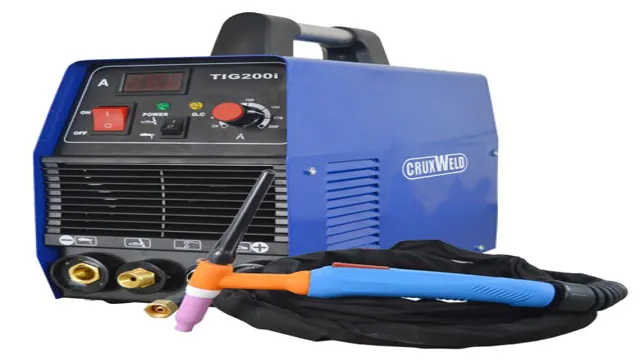What is Duty Cycle in Welding Machine: Understanding the Importance of Duty Cycle for Efficient Welding

Have you ever heard about duty cycle in welding machines? It’s an essential factor that every welder should understand to avoid damaging their equipment and compromising the quality of their work. Duty cycle refers to the period during which a welding machine can operate at its maximum before it needs to cool down. It’s expressed as a percentage and indicates the ratio between the time the machine can weld and the time it needs to rest.
For example, a machine with a 60% duty cycle can weld for six minutes and would require four minutes of rest. It’s vital to pay attention to this factor as overworking the machine can cause overheating and decrease its lifespan. So, how can you determine the right duty cycle for your machine? There’s no one-size-fits-all answer as it depends on the project’s size and complexity.
A higher duty cycle means faster completion of large projects, but a lower one is preferable for intricate ones that require more precision. Understanding the duty cycle in welding machines is crucial for ensuring the longevity of your equipment and the quality of your welding. So, the next time you’re gearing up for a project, don’t forget to factor in the duty cycle and weld away with confidence!
What is Duty Cycle?
If you’ve ever used a welding machine, you may have come across the term “duty cycle.” But what exactly does it mean? A duty cycle is a measure of how long a welding machine can operate before it needs to take a break and cool down. It’s typically expressed as a percentage, with higher percentages indicating that the machine is capable of sustained use for longer periods of time.
For example, a machine with a 50% duty cycle could be used for five minutes before it needs to cool down for another five minutes. This is important to consider when choosing a welding machine, as different types of jobs may require different duty cycles. If you plan to use a machine for heavy-duty welding projects, you’ll want to look for a machine with a higher duty cycle to avoid overheating and potential safety hazards.
Defining Duty Cycle
Duty cycle is a term commonly associated with electronic devices and electrical motors. It refers to the percentage of time during a given period that a device or motor can operate. For example, if a motor has a duty cycle of 50%, it means that it can run for half the time of its operating period before it needs to rest.
Duty cycle helps to define the operating limitations of a device and ensures it does not overheat or become damaged due to overuse. In simpler terms, the duty cycle is like a timer for a device, letting it know how long it can operate before needing a break. By understanding the duty cycle, you can better manage the usage of your electronic devices and prolong their lifespan.

Importance of Duty Cycle
Duty cycle is an essential concept in understanding the capabilities of electronic devices. It refers to the percentage of time that a device can operate without needing to rest. For example, if a device has a duty cycle of 50%, it can operate for half the time and then must rest for the remaining half.
This concept is crucial in understanding the limitations of devices and ensuring that they operate effectively. Duty cycle is often used in devices such as motors, generators, and transformers, as these devices need to rest to cool down and prevent overheating. It’s important to know the duty cycle of devices to prevent wear and tear, avoid damage, and extend their lifespan.
So, if you’re using any electronic device, make sure you know the duty cycle of the device to prevent any damage or failure.
Factors Affecting Duty Cycle
Duty Cycle Duty cycle refers to the ratio of time that a system is actively operating compared to the total time that it is available. This is commonly used in electronics, engineering, and mechanics where duty cycles are important in determining how various systems and components operate and function. The factors that can affect duty cycle include temperature, humidity, voltage, and load capacity.
Other factors that can also play a role in determining duty cycle include the type of equipment used, the environment in which it is operating, and the specific function that it is performing. Ultimately, duty cycle plays a crucial role in determining the overall performance and efficiency of a system and can impact its lifespan, as extended operation at high duty cycles can lead to increased wear and tear on components. By carefully monitoring and adjusting duty cycle, operators can optimize system performance and ensure the longevity of their equipment.
How is Duty Cycle Measured?
Duty cycle is an important metric in welding machines that measures the ratio of arc-on time to total cycle time. This metric is expressed as a percentage, where the arc-on time is the time taken to weld a specific material, and the total cycle time includes the welding and cooldown periods. To measure duty cycle accurately, a precise timer is required to monitor the arc-on and cool-down times.
Welding machines typically display duty cycle values in their specifications, allowing welders to compare machines and choose the most suitable one for their applications. It’s essential to understand the duty cycle of your welding machine to avoid overheating and damage to both the machine and the welds. Therefore, it’s crucial to follow the manufacturer’s recommendations on the maximum duty cycle and allow the machine to cool down before resuming welding.
By keeping the duty cycle within the recommended range, you can ensure high-quality welds and prolong the life of your machine.
Determining Duty Cycle of a Welding Machine
When considering the performance of a welding machine, its duty cycle is an important factor to consider. This refers to the amount of time the machine can operate continuously before needing to cool down. Duty cycle is typically measured as a percentage, based on a 10-minute cycle.
For example, a machine with a duty cycle of 60% can be used for 6 minutes before needing a 4-minute cool down period. It’s important to choose a welding machine with an appropriate duty cycle for the job at hand, based on the amount of welding required and the thickness of the material being welded. By understanding how duty cycle is measured, welders can select the right machine for the task and minimize downtime due to overheating.
So, always know the duty cycle percentage of your welding machine before jumping into the project to ensure its efficieny.
Interpreting Duty Cycle Ratings
When it comes to welding machines, understanding duty cycle ratings is crucial. Duty cycle refers to the amount of time a welder can operate before requiring a rest period. It is typically measured as a percentage of a 10-minute window, where the first number represents the minutes a machine can operate and the second number represents the required rest time.
For example, a 60% duty cycle at 200 amps means the machine can weld for six minutes before requiring four minutes of rest to cool down. A higher duty cycle rating indicates a welding machine’s ability to handle more consistent and longer welding jobs. It’s essential to choose the right duty cycle rating for your welding needs, as exceeding the stated duty cycle can result in overheating and potential damage to the machine.
How to Choose a Welding Machine Based on Duty Cycle?
Duty cycle is a crucial factor to consider when choosing a welding machine. Simply put, duty cycle refers to the amount of time a welder can operate at a specific amperage before it needs to be rested and cooled down. It’s typically expressed in a percentage and can range from as low as 10% to as high as 100%.
For instance, a 30% duty cycle on a welding machine means that it can operate for three minutes at a particular amperage before it needs to rest for seven minutes, which must be cool enough before it gets back to welding. It’s important to understand the duty cycle of a welding machine to avoid overheating and damaging the unit. A higher duty cycle means that you can perform more welding in less time, making it ideal for heavy-duty welding jobs.
Therefore, when choosing a welding machine, it’s important to consider the duty cycle that matches your welding needs.
Identifying Your Welding Needs
When it comes to choosing a welding machine, one of the most important factors to consider is the duty cycle. A duty cycle is the amount of time a welder can operate continuously before it needs to cool down. If you plan on using your welding machine for extended periods of time, it’s important to choose a machine with a high duty cycle.
The duty cycle is usually represented as a percentage, with the higher percentages indicating longer continuous use. For example, a machine with a 60% duty cycle can operate for six minutes out of every ten minutes before it needs to cool down, while a machine with a 20% duty cycle can operate for only two minutes out of every ten. As a general rule, if you’re a professional welder or plan on using your machine for long periods of time, you should choose a machine with at least a 60% duty cycle.
However, if you’re a hobbyist or only plan on using your machine occasionally, a lower duty cycle machine may be suitable for your needs. It’s also essential to understand that a machine’s duty cycle is affected by factors such as ambient temperature and the thickness of the material being welded. Therefore, it’s crucial to choose a machine with a duty cycle suitable for your specific welding needs, taking into account any potential variations.
By considering the duty cycle, you can select a welding machine that can meet your requirements and consistently deliver high-quality welds.
Matching Duty Cycle to Usage Requirements
When it comes to choosing a welding machine, it’s important to consider the duty cycle and how it matches up with your usage requirements. Duty cycle is the amount of time a welding machine can operate continuously before it needs to cool down. If you’re using a welding machine for short periods of time, a lower duty cycle may be acceptable.
However, if you’re using it for longer periods, such as in production settings, you’ll need a machine with a higher duty cycle. It’s important to match the duty cycle to your usage requirements so that the machine doesn’t overheat and cause damage. It’s also important to consider the type of welding you’ll be doing, as certain processes may require a higher duty cycle than others.
For example, MIG welding typically requires a lower duty cycle than TIG welding. When selecting a welding machine based on duty cycle, it’s important to look at the manufacturer’s specifications and ensure that the machine can handle the workload you’ll be putting it through. Don’t be tempted to skimp on this important factor, as a machine with a lower duty cycle than you need can lead to costly repairs and downtime.
By matching the duty cycle to your usage requirements, you’ll ensure that your welding machine can keep up with the demands of your job and provide you with consistent and reliable performance.
Conclusion
In summary, the duty cycle in welding machines is like the gas gauge in a car – it measures how much power you have left before you need to take a breather. But, unlike a car, taking a break in welding can mean the difference between a solid weld and a weak one. So, make sure to stay on top of your duty cycle and give your machine the rest it needs to keep you welding successfully.
“
FAQs
What is duty cycle in welding machine?
Duty cycle is the amount of time a welding machine can operate within a 10-minute period. It is usually expressed as a percentage, and represents the amount of time the machine can weld at its maximum output without overheating or damaging the components.
How is duty cycle calculated?
The duty cycle is calculated by dividing the welding time by the total 10-minute period and multiplying by 100%. For example, if a welder can operate for 6 minutes out of 10, the duty cycle is 60%.
Why is duty cycle important in welding?
The duty cycle is important because exceeding the recommended limit can damage the welding machine or reduce its lifespan. It also affects productivity, as a machine with a higher duty cycle can operate for longer periods without needing to cool down, thereby increasing efficiency.
What is the recommended duty cycle for a welding machine?
The recommended duty cycle for a welding machine varies depending on its type, size, and manufacturer. However, most industrial welding machines have a duty cycle between 30% to 60%, while smaller, hobbyist machines may have a duty cycle as low as 10%.
How can you increase the duty cycle of a welding machine?
The duty cycle of a welding machine can be increased by improving its cooling system, using a higher-quality electrode or wire, reducing the voltage or amperage used, or switching to a machine with a higher duty cycle and output capacity.
What happens if you exceed the duty cycle of a welding machine?
Exceeding the duty cycle of a welding machine can cause it to overheat, which can damage components, reduce performance, and potentially cause a fire. It can also reduce the lifespan of the machine and increase maintenance costs.
How does duty cycle affect the cost of a welding machine?
Welding machines with higher duty cycles and output capacities tend to be more expensive than those with lower duty cycles. However, investing in a higher-quality machine with a higher duty cycle can lead to increased productivity, less downtime, and lower maintenance costs in the long run.







